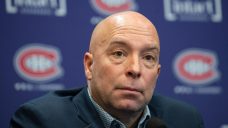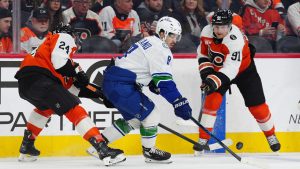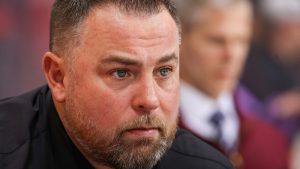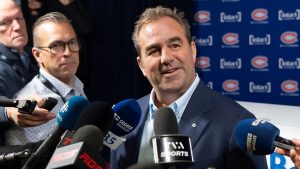We are inching closer to the 2023 NHL trade deadline on March 3. Over the past several weeks I have dissected the depth charts and needs of Canadian franchises – Vancouver Canucks, Edmonton Oilers, Winnipeg Jets and Montreal Canadiens.
Next up on the calendar is the team based in our nation’s capital.
Here’s a deep dive on the Ottawa Senators:
ROSTER AND SALARY CAP

• Brady Tkachuk’s contract ends at the conclusion of the 2027-28 season. He has a full no-move clause in the last three seasons of the deal.
• Tim Stutzle’s contract extension begins in 2023-24 and runs through the 2030-31 season. The deal includes a modified no-movement clause (10 teams) in the last four years.

• Thomas Chabot’s contract expires at the conclusion of the 2027-28 season and carries a modified no-movement clause in the last four years.
• Artem Zub’s contract runs through 2026-27 and has a modified no-move clause (10 teams).


• Josh Norris’s contract expires at the end of the 2029-30 season. It includes a modified no-trade (10 teams) in the last four years.


DRAFT CAPITAL

NHL FORWARDS
On any given night the Senators have the potential to run and gun with any team in the league. They aren’t armed with a 50-goal scorer, or extreme high-end skill, but collectively they have a group of forwards who can be creative and produce offence.
Where they struggle, in my opinion, is with consistent defensive zone detail and support from their forward group. When the team doesn’t start with the puck, from a defensive zone face-off for example, they seem to have difficulty consistently identifying responsibilities and remaining focused off the puck.
Brady Tkachuk: The Senators' captain leads by example. He’s a power forward who can play the game any way the team wants him to. His ability to extend plays along the boards and out front of the opponents' net leads to second chances and goals for the Senators. Tkachuk averages just over 18 minutes of ice time per game and is deployed at even strength and the power-play. He tries to carry the team on his back every night.
Tim Stutzle: Leads the forward group, averaging 21 minutes per game in the Senators' last 10-game segment.
He’s used in all situations, but I don’t love him on the penalty kill. He uses up a ton of energy on the PK and doesn’t look comfortable at times. He tries to pressure the puck and rotate into lanes, but gets caught halfway in between too often for my liking. He is very dangerous on the power play, though. He generally works off the weak side and creates. Stutzle plays quick and fast and he has skill off the rush. He competes. Overall he’s a smart investment for the Senators.
Claude Giroux: The veteran forward has mostly played to the level I projected him to contribute at this year, given the fact he is 35 years old. Giroux averages around 19 minutes of ice time, is used in all situations and continues to be one of the top face-off winners in the NHL. In his past 10 games he has produced six goals and five assists, directed 50 shots towards the net (hitting on 30 of them) and won 60 per cent of his draws. All NHL teams run set plays off face-offs and want to start with the puck. Giroux gives the Senators a head start when he is taking draws. Giroux is crafty at this stage of his career and picks his spots – changing gears – in transition. He’s on pace for 30 goals.
Drake Batherson: He is producing his share offensively (15 goals, 28 assists), especially on the power-play (11 goals, 11 assists). On straight lines heading north, he has the ability to attack with pace and the puck skill to beat opponents 1-on-1. As soon as he sees an opportunity to move to the middle of the ice off the half wall he is directing pucks on goal. On the power-play he is an asset to have around the crease.
Defensively, Batherson has a long way to go. His detail ranges wildly. If his line loses a defensive zone face-off it’s 50/50 at best if they are aware enough on and off the puck to identify and commit themselves to keeping the puck out of the net.
Alex DeBrincat: I’m well aware of what DeBrincat’s element is. He’s a shooter who provides offence, especially on the power-play. Half of his points this year have come with the man advantage, where he has seven goals and 14 assists. DeBrincat thrives in a puck control environment. He rarely arrives on the scene first if the Senators elect to chip and chase off the rush. His lack of energy, and detail, can be alarming at times on defence. If he contributed average defensive zone effort it would make it easier for me to accept some of the defensive deficiencies in his game. He can give more.
(Note: DeBrincat is a pending RFA and his qualifying offer is set at $9 million this off-season. Some perspective is required when considering his qualifying offer. He would become the Senators' highest paid player if they elect to keep him.)
Shane Pinto: Pinto is skating in his first full NHL season after suffering injury last year. The 6-foot-2, 192-pound centre has shown some positive growth. He’s being used on one of the power-play units as the middle bumper/crease crasher. Pinto doesn’t need much time to get his snap shot off from scoring areas. He has a great release. His overall detail defensively has mirrored that of the entire team. He will take some time to adapt. Pinto averages around 16 minutes TOI and is deployed at ES and the PP.
Derick Brassard: He has been surviving in the league via a series of one-year contracts. He’s a veteran player who can create some offence on the power-play, but is limited at even strength. I appreciate he adds some depth to the Senators, but I don’t see a fit after this season. In 42 games Brassard has contributed 13 points with seven coming on the power-play.
Mathieu Joseph: Joseph has only played 33 games this season due to injury, but when he’s in the lineup he provides the Senators exactly what you look for in a bottom six forward. He is used primarily at even strength and the penalty kill. The 6-foot-1, 190-pound forward averages 14 minutes of ice time. He contributes secondary offence (three goals, 10 assists) and can be relied upon to start and end periods with his responsible play. I continue to appreciate Joseph’s game. He’s an energy provider who competes every night.
Austin Watson: Watson is a pending UFA who brings some grit to the bottom of the lineup. The 6-foot-4, 198-pound, right shot forward averages just over 10 minutes of ice time at even strength and the penalty kill. Occasionally Watson chips in offensively, but he’s more defined as a role forward who will stir the pot and pay the price for his team. If there is interest from a team at the deadline, I would trade Watson for a mid-round pick in 2023 if possible.
Parker Kelly: Kelly is an example of a prospect who scored at a point per game rate at the major junior Level (Prince Albert Raiders, WHL) but has had to re-invent himself to a degree at the NHL level. He’s not the biggest Senator forward (5-foot-11, 170 pounds) but he’s a tenacious competitor who leads the team with 153 hits. Kelly has found a role in the bottom six forward group, averaging 10 minutes of ice time deployed at even strength and the penalty kill. I appreciate his game and believe he fills an important role going forward – one that he seems to embrace.
DEPTH FORWARDS
The bottom of the Senators lineup is filled with a mix of size, quickness, and occasional secondary offence. Players like Mark Kastelic, Tyler Motte and Dylan Gambrell all bring something different to the equation, but have to be considered fringe contributors at this time.
Note: Motte could possibly fetch a draft pick in return at the deadline. He plays to a consistent identity (energy/PK/occasional offence) that teams can trust if they are looking to add some additional depth. He’s a pending UFA, too.
INJURED RESERVE
Not having Josh Norris around for most of the season has been a massive blow to the Senators. He scored 35 goals last season, including 19 on the power-play and eight game-winning goals. Not having him in the lineup certainly wasn’t what the Senators expected, or needed, as they attempted to take the next step with their core group and additions. Norris is signed through 2029-30 and carries a cap hit of $7.95M.
NHL DEFENCEMEN
Thomas Chabot: Chabot is one of the best skaters in the NHL. He’s a transitional defender who eats up north of 25 minutes of ice on a nightly basis. It’s incredible to think he is rarely used on the penalty kill and still reaches that amount of ice time. On some nights (like this past Saturday versus Edmonton) he struggles with his detail and puck management. But overall, he is an absolute workhorse who is a threat off the rush when he decides to jump through the neutral zone, and he is the QB on the Senators' power-play (ranked third in the NHL at 26.4 per cent). He’s part of the Senators core moving forward, signed through 2027-28 with an $8 million cap hit.
Artem Zub: The Senators are a better team defensively when Zub is in the lineup. He’s missed significant time this year due to injury and the team struggled without him. Zub averages around 22 minutes of ice time per game and is deployed at even strength and penalty kill. He’s a “glue guy” who can be paired with more active partners (like Chabot) and relied upon to “protect the house”. On occasion he will chip in offensively, but it’s his heavy lifting that brings maximum value. (E.G. Zub has 75 hits in only 23 games played). Zub’s contract extension kicks in next season ($4.6M cap hit) and runs through 2026-27. There’s no chance I would entertain trade calls on Zub. He’s too valuable to the Senators moving forward.
Nikita Zaitsev: Without going into too much detail, things aren’t working in the marriage between the Senators and this player. The Sens would like to move him, but he has a 10-team no trade list and he’s signed through next season with a $4.5 million cap hit. When he plays, he averages just shy of 17 minutes of ice time at even strength and the penalty kill. His game lacks detail and execution. I get the feeling the Sens are going to have to spend some of their draft capital to convince a trade partner to take on his contract.
Travis Hamonic: I’m a bit torn on Hamonic, to be honest. On one hand I appreciate he does bring some leadership and mentorship to someone like rookie defender Jake Sanderson. On the other hand, there are nights he puts more pressure on his defensive partner with his style of play at this stage of his career. The bottom line is Hamonic averages 19 minutes of, generally, hard match up/even strength minutes and the penalty kill. It’s my opinion he would be better suited for a No. 5 or No. 6 role on a contending team than a top four role in Ottawa. He leads the Sens with 96 shot blocks, but only has 70 hits on the year. Those stats tell me he is slower arriving with his gaps, but has adjusted by trying to get in the lane and block shots.
Jake Sanderson: The rookie defenceman is part of the core group moving forward for the Senators. He’s an excellent skater who can transition pucks on his own or join the rush as an extra layer – and return to defend on time. He went down with injury on the weekend and sounds like he will be out a couple of weeks. Sanderson’s last 10-game segment shows he was averaging over 22 minutes of ice and being deployed in all situations. He scored a goal and four assists over that span. Sanderson projects as a top pairing defenceman moving forward.
Nick Holden: Holden averages just under 17 minutes of ice time and is used at even strength and the penalty kill. The 35-year-old veteran plays a simple/responsible game without much risk. He isn’t punishing and he isn’t necessarily a shot blocker. Holden quietly and efficiently goes about his business defending and moving pucks – chipping the play out of his zone. He’s on an expiring contract. There will be interest in Holden at the deadline for a depth role on a playoff contending team. He has a 10-team no trade clause in his contract, however.
Erik Brannstrom: When Brannstrom was originally drafted he projected to have more offensive upside as a transitional defender. His offence has taken a back seat this season and Brannstrom’s game is now more defined as a two-way “D”. He moves well and has a better understanding of what will keep him in the NHL. He generally makes safe outlets and occasionally will join the rush. Brannstrom has value as a depth defenceman. He has averaged 15 minutes of ice time for the season in 47 games played and is used at even strength, PK, and sometimes on the second power-play unit. Brannstrom is a pending RFA this off-season, with a qualifying offer is set at $945,000. He’s worth the investment. Time will tell how he continues to evolve.
NHL GOALIES
The Senators' goaltending situation resembles a M.A.S.H unit in its current state. Cam Talbot is on injured reserve with a lower body injury and Anton Forsberg suffered torn ligaments in both knees on the weekend versus Edmonton. The Sens are in tough to make a playoff push and now have to rely on unproven prospects Mads Sogaard and Kevin Mandolese for the foreseeable future.
Cam Talbot: Talbot is 35 years old, on an expiring contract and set to become a UFA this summer. His season in Ottawa, before his injury, hasn’t been terrible – but it also hasn’t been sensational. He’s been average on most nights and rarely showed he is capable of stealing games for the Sens. The team certainly could have been better in front of him in the defensive zone. Too many high danger chances against expose Talbot’s lack of high end quickness and scramble ability at this stage of his career. He currently sports a 2.90 GAA and .905 save percentage. If there is interest at the deadline, I would move him for a mid-round pick in 2023.
Anton Forsberg: Forsberg will unfortunately miss the remainder of the season, rehabbing both knees, after suffering an unfortunate injury on the weekend. Before going down he had a 3.26 GAA and .902 save percentage. His year has been inconsistent. Some nights he was all world, other nights he allowed goals from obscene angles on the ice. He’s signed through 2024-25 with a contract that carries a cap hit of $2.75M. Forsberg is somewhere between a No. 2 and a 1B – but he's not a No. 1. Hopefully he rehabs well and comes back healthy.
Mads Sogaard: Sogaard is a giant at 6-foot-7, 196 pounds. His year in Belleville has been uneven, though, with a 3.30 GAA and .898 save percentage. He will be challenged to track the speed of the NHL game laterally. “Less is more” with Sogaard. He can play deep in his net at his stature and needs to remain between his posts. He’s not a great scrambler if he gets wandering.
Kevin Mandolese: Mandolese is also a big goalie (6-foot-5, 200 pounds), but he’s more active than Sogaard. Mandolese has to limit the number of second chances against. His rebound control (active pads) gets him in trouble at times. He too has been average (at best) in Belleville, where Mandolese has a 3.60 GAA and .879 save percentage in the AHL this season.
TWO PROSPECTS
Egor Sokolov: Sokolov is a player I can’t help but root for. He’s dedicated himself to improving his foot speed and fitness. The 6-foot-5, 215-pound right-shot winger is having a nice season in Belleville, with 12 goals and 28 assists in 46 games. His off-the-puck detail needs to continue to improve, but he’s making an effort in all three zones. Sokolov has really good puck touch, and an NHL release. He can extend plays in the hard areas and create traffic around the net. It’s getting close to decision time on Sokolov. He’s a pending RFA this summer.
Ridly Greig: Greig is one of my favourite Senators prospects. He’s a tenacious competitor who can be used in a variety of roles. He’s played six games with the NHL Senators (zero goals, three assists) and averaged just over 14 minutes of ice time. Before his call-up Greig had scored 12 goals and 11 assists in AHL Belleville in 28 games. The 20-year-old forward punches above his weight (5-foot-11, 163 pounds). He’s like a rash that never goes away.
TRADE DEADLINE APPROACH 2023
It’s my opinion the Senators were dealt several hands of bad luck this season. I appreciate how aggressive Pierre Dorion, and his staff, were last off-season and believe they are tracking positively overall.
Having said that, I’m not confident the team can make up the eight-plus points required to move into a playoff spot. They have players who will be of interest to teams at the deadline.
Here are some projected returns if Ottawa were to make some trades:
Austin Watson: I would ask for a 2023 third-round pick, especially if I have to retain salary. It’s more likely he fetches a fourth, but I wouldn’t retain 50 per cent salary if that’s the case.
Cam Talbot: If he’s healthy there will be a market for Talbot. I would target Vegas and ask for their third-round pick (from Buffalo) in 2023, knowing I might have to retain some salary in the deal.
Nick Holden: Holden could be a nice “buy low” addition for a team. He’s a “steady eddy” who can slide into a No. 5 or No. 6 role and match-up against middle six forwards. Holden is affordable. I’m sounding like a broken record, but if I have to retain 50 per cent of his salary in the deal the cost would have to be a third-round pick in 2023.
Nikita Zaitsev: It stings a bit, but the team needs to get off this contract. Zaitsev might be a player a team like Anaheim or Arizona are willing to take on. It’s going to be an unusual transaction, however, because the Senators are going to lose the deal due to his contract. They also don’t completely control where he goes since Zaitsev has a 10-team no-trade list. If he does agree to go to, say, Anaheim, the cost would look like Zaitsev and their second-round pick in 2024 for Aneheim’s fourth-round pick in 2024, provided the Ducks take on the entirety of Zaitsev’s contract.



 4:46
4:46

